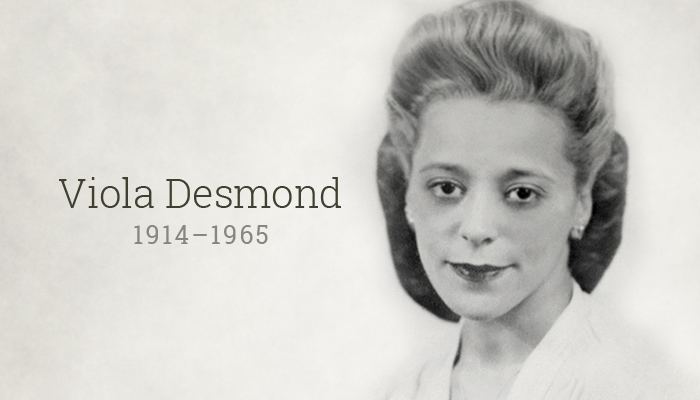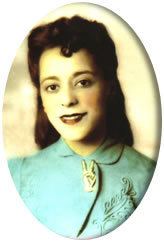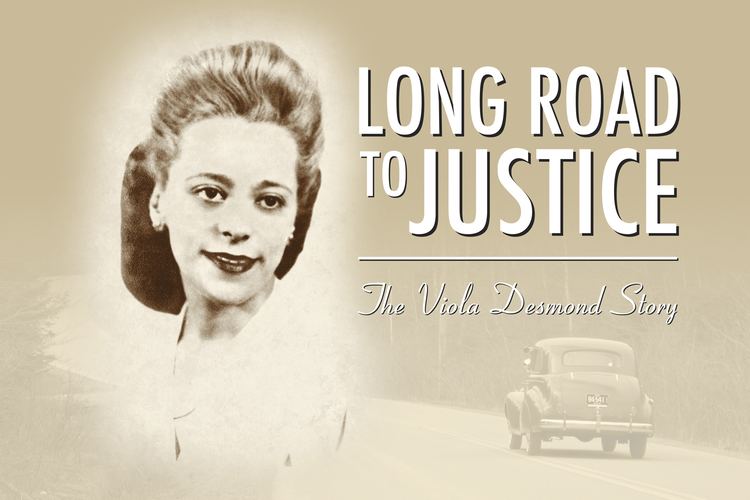Nationality Canada Education Bloomfield High School Name Viola Desmond | Spouse(s) Jack Desmond Occupation Beautician | |
 | ||
Full Name Viola Irene Davis Died February 7, 1965, New York City, New York, United States | ||
Long road to justice the viola desmond story full documentary
Viola Irene Desmond (July 6, 1914 – February 7, 1965) was a Canadian Black Nova Scotian businesswoman who challenged racial segregation at a film theatre in New Glasgow, Nova Scotia, in 1946. She refused to leave a whites-only area of the Roseland Theatre and was convicted of a minor tax violation for the one-cent tax difference between her paid and used seat. Desmond's case is one of the most publicized incidents of racial discrimination in Canadian history and helped start the modern civil rights movement in Canada.
Contents
- Long road to justice the viola desmond story full documentary
- Viola desmond an unlikely crusader
- Biography
- Arrest
- Trials
- Later life
- Legacy and honours
- Apology and pardon
- References

In 2010, Desmond was granted a posthumous pardon, the first to be granted in Canada. The government of Nova Scotia also apologized for prosecuting her for tax evasion, and acknowledged she was rightfully resisting racial discrimination. In 2016, the Bank of Canada announced that Desmond will be the first Canadian woman to be featured on the front of a banknote. She is slated to appear on the $10 bill in 2018.

Viola desmond an unlikely crusader
Biography

Viola Desmond (née Davis) was born on July 6, 1914, one of ten children of James Albert and Gwendolin Irene (née Johnson) Davis. Viola grew up with parents who were active in the black community in Halifax, despite the fact that her mother was white and her father black, unusual for the time.

Growing up, Desmond noted the absence of professional hair- and skin-care products for black women, and set her sights on addressing the need. Being of African descent, Viola Desmond was not allowed to train to become a beautician in Halifax, so she left and received beautician training in Montreal, Atlantic City, and one of Madam C. J. Walker's beauty schools in New York. Upon finishing her training, Viola Desmond returned to Halifax to start her own hair salon. Her clients included Portia White and a young Gwen Jenkins, later the first black nurse in Nova Scotia.
In addition to the salon, Desmond set up The Desmond School of Beauty Culture so that black women would not have to travel as far as she did to receive proper training. Catering to women from Nova Scotia, New Brunswick and Quebec, the school operated using a vertical integration framework. Students were provided with the skills required to open their own businesses and provide jobs for other black women within their communities. Each year as many as fifteen women graduated from the school, all of whom had been denied admission to whites-only training schools. Desmond also started her own line of beauty products, Vi's Beauty Products which she marketed and sold herself.
Arrest
Viola Desmond joined her husband Jack Desmond in a combined barbershop and hairdressing salon, a beauty parlour on Gottingen Street. While on a business trip to sell her beauty products, Viola went to New Glasgow in 1946. While driving through New Glasgow on November 8, 1946, Viola Desmond's car broke down and she was told that she would have to wait a day before the parts to fix it became available. To pass the time while waiting, she went to see The Dark Mirror at the Roseland Film Theatre.
Desmond bought a ticket, asking for a seat on the main floor. As she took a seat on the main floor, she was told by the manager that she did not have the ticket for that seat. She returned to the ticket booth, where she was informed that it was against their policy to give a main floor seat ticket to a black person. Desmond returned to the main floor and refused to sit in the balcony designated exclusively for blacks in the segregated Roseland Theatre. She was forcibly removed from the theatre and arrested, causing injury to her hip. Desmond was kept in jail overnight and was never informed about her right to legal advice, a lawyer, or bail.
Desmond was charged with tax evasion over failing to pay the one-cent difference in tax between the cheaper balcony and the slightly more expensive main floor tickets. She was fined C$20 (equivalent to $273 in 2016) and court costs of $6. She paid the fine and returned to Halifax.
Trials
Upon returning to Halifax, Desmond discussed the matter with her husband, and his advice was to let it go. However, when she sought advice from the leaders of her church, the Cornwallis Street Baptist Church, Minister William Pearly Oliver and his wife Pearline encouraged her to take action. With their support, Desmond decided to fight the charge in court.
Following the decision to fight the charge, Carrie Best broke the story of Desmond in the first edition of The Clarion, the first black-owned and published Nova Scotia newspaper. Best had herself previously confronted the racial segregation of the Roseland Theatre.
With the help of her church and the Nova Scotia Association for the Advancement of Coloured People (NSAACP), Desmond hired a lawyer, Frederick William Bissett, who represented her in the criminal trials and attempted, unsuccessfully, to file a lawsuit against the Roseland Theatre.
During subsequent trials the government insisted on arguing that this was a case of tax evasion. A provincial act regulating cinemas and movie theatres required the payment of an amusement tax based on the price of the theatre ticket. Since the theatre would only agree to sell Desmond a cheaper balcony ticket, but she had insisted upon sitting in the more expensive main floor seat, she was one cent short on tax. The statute used to convict Desmond contained no explicitly racist or discriminatory language.
Bissett's decision to opt for a judicial review rather than appeal the original conviction proved disastrous. Further, Desmond's lawyer tried to appeal the decision on the basis of her being wrongfully accused of tax evasion – not on the basis of racial discrimination. When dismissing the case, Justice William Lorimer Hall said:
Had the matter reached the court by some other method than certiorari there might have been an opportunity to right the wrong done this unfortunate woman. One wonders if the manager of the theatre who laid the complaint was so zealous because of a bona fide belief that there had been an attempt to defraud the province of Nova Scotia of the sum of one cent, or was it a surreptitious endeavour to enforce a Jim Crow rule by misuse of a public statute.
Her lawyer Bissett refused to bill Desmond and the money was used to support Dr. William Pearly Oliver's newly established Nova Scotia Association for the Advancement of Coloured People (NSAACP).
Later life
After the trial, Desmond closed her business and moved to Montreal where she could enroll in a business college. She eventually settled in New York, US, where she died from a gastrointestinal hemorrhage on February 7, 1965, at the age of 50. She is buried at Camp Hill Cemetery in Halifax, Nova Scotia.
Legacy and honours
Dr. Oliver later reflected on Desmond's legacy:
... this meant something to our people. Neither before or since has there been such an aggressive effort to obtain rights. The people arose as one and with one voice. This positive stand enhanced the prestige of the Negro community throughout the Province. It is my conviction that much of the positive action that has since taken place stemmed from this ...
Desmond is often compared to Rosa Parks, given they both challenged racism and contributed to the rise of the Civil Rights Movement. At the same time, there are significant differences between the two figures. Desmond lived in a different legislative context than Parks, given there were no Jim Crow laws in Canada. Parks decision to sit at the front of the bus was an act of civil disobedience against Jim Crow laws that supported segregation on public transit. In contrast, Desmond was protesting a private theatre owner's efforts at segregation, which were not supported by provincial laws.
In 2000, Desmond and other Canadian civil rights activists were the subject of a National Film Board of Canada documentary Journey to Justice. A documentary film was made about her, entitled Long Road to Justice: The Viola Desmond Story.
Cape Breton University established a scholarship campaign in the names of Viola Desmond and Wanda Robson, and named a Chair in Social Justice after Desmond.
Her sister, Wanda Robson, wrote a book about activism in her family and her experiences with her sister, titled Sister to Courage. Desmond was also the subject of a children's book Viola Desmond Won't Be Budged by Jody Nyasha Warner.
Singer Faith Nolan wrote a song about her.
In 2012, Desmond was portrayed on a commemorative stamp issued by Canada Post.
On February 2, 2016, Historica Canada featured Desmond in a Heritage Minute, filmed on location in High River, Alberta, in June 2015. The video features Kandyse McClure as Viola Desmond. She became the first historical woman of colour to feature in a Heritage Minute.
On July 7, 2016, a Halifax harbour ferry was launched bearing her name, along with the Christopher Stannix and Craig Blake.
On December 8, 2016, she was chosen as the first Canadian woman to appear on the Canadian ten-dollar note after being on a shortlist of five. The note will be issued in 2018.
Apology and pardon
On April 14, 2010, the Lieutenant Governor of Nova Scotia, Mayann Francis, on the advice of her premier, invoked the Royal Prerogative and granted Desmond a posthumous free pardon, the first such to be granted in Canada. The free pardon, an extraordinary remedy granted under the Royal Prerogative of Mercy only in the rarest of circumstances and the first one granted posthumously, differs from a simple pardon in that it is based on innocence and recognizes that a conviction was in error. Francis, herself a Black Canadian, remarked: "Here I am, 64 years later – a black woman giving freedom to another black woman", about her signing of the pardon.
The government of Nova Scotia also apologized. Desmond's younger sister Wanda Robson and Dr. Graham Reynolds, a professor of Cape Breton University, worked with the Government of Nova Scotia to ensure that Desmond's name was cleared, there was a public acknowledgement of the injustice and Nova Scotia reaffirmed its commitment to Human Rights. The provincial government has declared the first Nova Scotia Heritage Day in her honour in February 2015. Desmond's portrait also hangs in Government House in Halifax, Nova Scotia.
